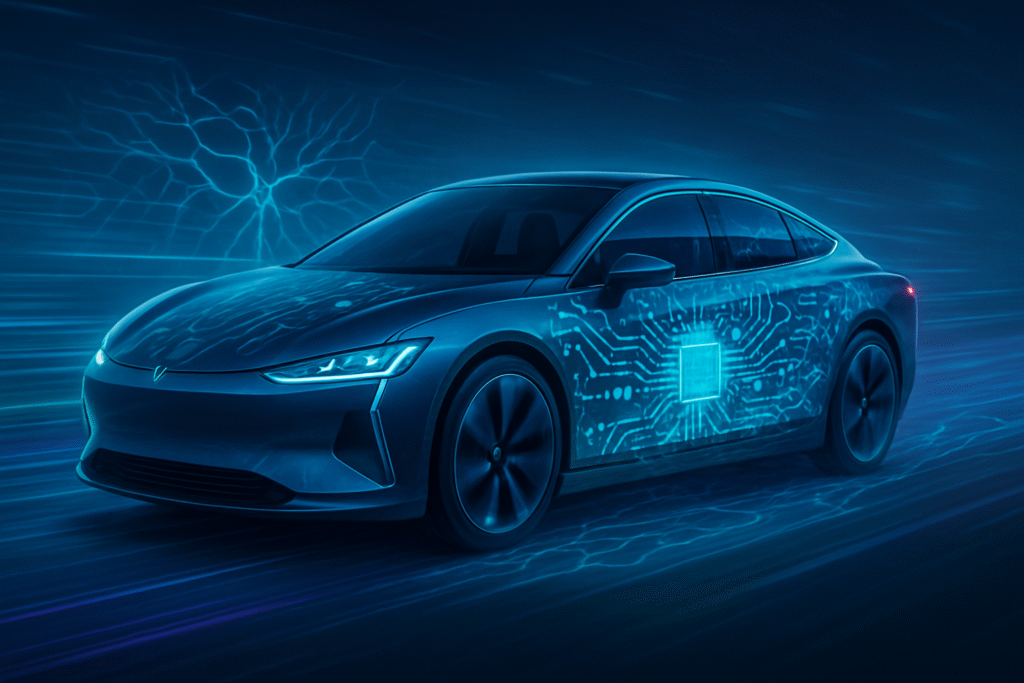
October 4, 2025 – The automotive industry is in the midst of a profound transformation, shifting from mechanical conveyances to sophisticated, software-defined computing platforms. At the heart of this revolution lies the humble semiconductor, now elevated to a mission-critical component. As of October 2025, the escalating demand from Electric Vehicles (EVs) and advanced autonomous driving (AD) systems is not merely fueling unprecedented growth in the chip market but is fundamentally reshaping vehicle architecture, manufacturing strategies, and the broader technological landscape. The global automotive semiconductor market, valued at approximately $50 billion in 2023, is projected to surpass $100 billion by 2030, with EVs and ADAS/AD systems serving as the primary catalysts for this exponential expansion.
This surge is driven by a dramatic increase in semiconductor content per vehicle. While a traditional internal combustion engine (ICE) vehicle might contain 400 to 600 semiconductors, an EV can house between 1,500 and 3,000 chips, with a value ranging from $1,500 to $3,000. Autonomous vehicles demand an even higher value of semiconductors due to their immense computational needs. This paradigm shift has repositioned the automotive sector as a primary growth engine for the chip industry, pushing the boundaries of innovation and demanding unprecedented levels of performance, reliability, and efficiency from semiconductor manufacturers.
The Technical Revolution Under the Hood: Powering the Future of Mobility
The technical advancements in automotive semiconductors are multifaceted, addressing the unique and stringent requirements of modern vehicles. A significant development is the widespread adoption of Wide-Bandgap (WBG) materials such as Silicon Carbide (SiC) and Gallium Nitride (GaN). These materials are rapidly replacing traditional silicon in power electronics due to their superior efficiency, higher voltage tolerance, and significantly lower energy loss. For EVs, this translates directly into extended driving ranges and faster charging times. The adoption of SiC in EVs alone is projected to exceed 60% by 2030, a substantial leap from less than 20% in 2022. This shift is particularly crucial for the transition to 800V architectures in many new EVs, which necessitate advanced SiC MOSFETs capable of handling higher voltages with minimal switching losses.
Beyond power management, the computational demands of autonomous driving have spurred the development of highly integrated Advanced System-on-Chip (SoC) Architectures. These powerful SoCs integrate multiple processing units—CPUs, GPUs, and specialized AI accelerators (NPUs)—onto a single chip. This consolidation is essential for handling the massive amounts of data generated by an array of sensors (LiDAR, radar, cameras, ultrasonic) in real-time, enabling complex tasks like sensor fusion, object detection, path planning, and instantaneous decision-making. This approach marks a significant departure from previous, more distributed electronic control unit (ECU) architectures, moving towards centralized, domain-controller-based designs that are more efficient and scalable for software-defined vehicles (SDVs). Initial reactions from the automotive research community highlight the necessity of these integrated solutions, emphasizing the critical role of custom AI hardware for achieving higher levels of autonomy safely and efficiently.
The focus on Edge AI and High-Performance Computing (HPC) within the vehicle itself is another critical technical trend. Autonomous vehicles must process terabytes of data locally, in real-time, rather than relying solely on cloud-based processing, which introduces unacceptable latency for safety-critical functions. This necessitates the development of powerful, energy-efficient AI processors and specialized memory solutions, including dedicated Neural Processing Units (NPUs) optimized for machine learning inference. These chips are designed to operate under extreme environmental conditions, meet stringent automotive safety integrity levels (ASIL), and consume minimal power, a stark contrast to the less demanding environments of consumer electronics. The transition to software-defined vehicles (SDVs) further accentuates this need, as advanced semiconductors enable continuous over-the-air (OTA) updates and personalized experiences, transforming the vehicle into a continuously evolving digital platform.
Competitive Dynamics: Reshaping the Industry's Major Players
The burgeoning demand for automotive semiconductors is profoundly impacting the competitive landscape, creating both immense opportunities and strategic challenges for chipmakers, automakers, and AI companies. Traditional semiconductor giants like Intel Corporation (NASDAQ: INTC), through its subsidiary Mobileye, and QUALCOMM Incorporated (NASDAQ: QCOM), with its Snapdragon Digital Chassis, are solidifying their positions as key players in the autonomous driving and connected car segments. These companies benefit from their deep expertise in complex SoC design and AI acceleration, providing integrated platforms that encompass everything from advanced driver-assistance systems (ADAS) to infotainment and telematics.
The competitive implications are significant. Automakers are increasingly forming direct partnerships with semiconductor suppliers and even investing in in-house chip design capabilities to secure long-term supply and gain more control over their technological roadmaps. For example, Tesla, Inc. (NASDAQ: TSLA) has been a pioneer in designing its own custom AI chips for autonomous driving, demonstrating a strategic move to internalize critical technology. This trend poses a potential disruption to traditional Tier 1 automotive suppliers, who historically acted as intermediaries between chipmakers and car manufacturers. Companies like NVIDIA Corporation (NASDAQ: NVDA), with its DRIVE platform, are also aggressively expanding their footprint, leveraging their GPU expertise for AI-powered autonomous driving solutions, challenging established players and offering high-performance alternatives.
Startups specializing in specific areas, such as neuromorphic computing or specialized AI accelerators, also stand to benefit by offering innovative solutions that address niche requirements for efficiency and processing power. However, the high barriers to entry in automotive—due to rigorous safety standards, long development cycles, and significant capital investment—mean that consolidation and strategic alliances are likely to become more prevalent. Market positioning is increasingly defined by the ability to offer comprehensive, scalable, and highly reliable semiconductor solutions that can meet the evolving demands of software-defined vehicles and advanced autonomy, compelling tech giants to deepen their automotive focus and automakers to become more vertically integrated in their electronics supply chains.
Broader Significance: A Catalyst for AI and Supply Chain Evolution
The escalating need for sophisticated semiconductors in the automotive industry is a significant force driving the broader AI landscape and related technological trends. Vehicles are rapidly becoming "servers on wheels," generating terabytes of data that demand immediate, on-device processing. This imperative accelerates the development of Edge AI, pushing the boundaries of energy-efficient, high-performance computing in constrained environments. The automotive sector's rigorous demands for reliability, safety, and long-term support are also influencing chip design methodologies and validation processes across the entire semiconductor industry.
The impacts extend beyond technological innovation to economic and geopolitical concerns. The semiconductor shortages of 2021-2022 served as a stark reminder of the critical need for resilient supply chains. As of October 2025, while some short-term oversupply in certain automotive segments due to slowing EV demand in specific regions has been noted, the long-term trend remains one of robust growth, particularly for specialized components like SiC and AI chips. This necessitates ongoing efforts from governments and industry players to diversify manufacturing bases, invest in domestic chip production, and foster greater transparency across the supply chain. Potential concerns include the environmental impact of increased chip production and the ethical implications of AI decision-making in autonomous systems, which require robust regulatory frameworks and industry standards.
Comparisons to previous AI milestones reveal that the automotive industry is acting as a crucial proving ground for real-world AI deployment. Unlike controlled environments or cloud-based applications, automotive AI must operate flawlessly in dynamic, unpredictable real-world scenarios, making it one of the most challenging and impactful applications of artificial intelligence. This pushes innovation in areas like computer vision, sensor fusion, and reinforcement learning, with breakthroughs in automotive AI often having ripple effects across other industries requiring robust edge intelligence. The industry's push for high-performance, low-power AI chips is a direct response to these demands, shaping the future trajectory of AI hardware.
The Road Ahead: Anticipating Future Developments
Looking ahead, the automotive semiconductor landscape is poised for continuous innovation. In the near-term, we can expect further advancements in Wide-Bandgap materials, with SiC and GaN becoming even more ubiquitous in EV power electronics, potentially leading to even smaller, lighter, and more efficient power modules. There will also be a strong emphasis on chiplet-based designs and advanced packaging technologies, allowing for greater modularity, higher integration density, and improved manufacturing flexibility for complex automotive SoCs. These designs will enable automakers to customize their chip solutions more effectively, tailoring performance and cost to specific vehicle segments.
Longer-term, the focus will shift towards more advanced AI architectures, including exploration into neuromorphic computing for highly efficient, brain-inspired processing, particularly for tasks like pattern recognition and real-time learning in autonomous systems. Quantum computing, while still nascent, could also play a role in optimizing complex routing and logistics problems for fleets of autonomous vehicles. Potential applications on the horizon include highly personalized in-cabin experiences driven by AI, predictive maintenance systems that leverage real-time sensor data, and sophisticated vehicle-to-everything (V2X) communication that enables seamless interaction with smart city infrastructure.
However, significant challenges remain. Ensuring the cybersecurity of increasingly connected and software-dependent vehicles is paramount, requiring robust hardware-level security features. The development of universally accepted safety standards for AI-driven autonomous systems continues to be a complex undertaking, necessitating collaboration between industry, academia, and regulatory bodies. Furthermore, managing the immense software complexity of SDVs and ensuring seamless over-the-air updates will be a continuous challenge. Experts predict a future where vehicle hardware platforms become increasingly standardized, while differentiation shifts almost entirely to software and AI capabilities, making the underlying semiconductor foundation more critical than ever.
A New Era for Automotive Intelligence
In summary, the automotive semiconductor industry is undergoing an unprecedented transformation, driven by the relentless march of Electric Vehicles and autonomous driving. Key takeaways include the dramatic increase in chip content per vehicle, the pivotal role of Wide-Bandgap materials like SiC, and the emergence of highly integrated SoCs and Edge AI for real-time processing. This shift has reshaped competitive dynamics, with automakers seeking greater control over their semiconductor supply chains and tech giants vying for dominance in this lucrative market.
This development marks a significant milestone in AI history, demonstrating how real-world, safety-critical applications are pushing the boundaries of semiconductor technology and AI research. The automotive sector is serving as a crucible for advanced AI, driving innovation in hardware, software, and system integration. The long-term impact will be a fundamentally re-imagined mobility ecosystem, characterized by safer, more efficient, and more intelligent vehicles.
In the coming weeks and months, it will be crucial to watch for further announcements regarding strategic partnerships between automakers and chip manufacturers, new breakthroughs in energy-efficient AI processors, and advancements in regulatory frameworks for autonomous driving. The journey towards fully intelligent vehicles is well underway, and the silicon beneath the hood is paving the path forward.
This content is intended for informational purposes only and represents analysis of current AI developments.
TokenRing AI delivers enterprise-grade solutions for multi-agent AI workflow orchestration, AI-powered development tools, and seamless remote collaboration platforms. For more information, visit https://www.tokenring.ai/.




